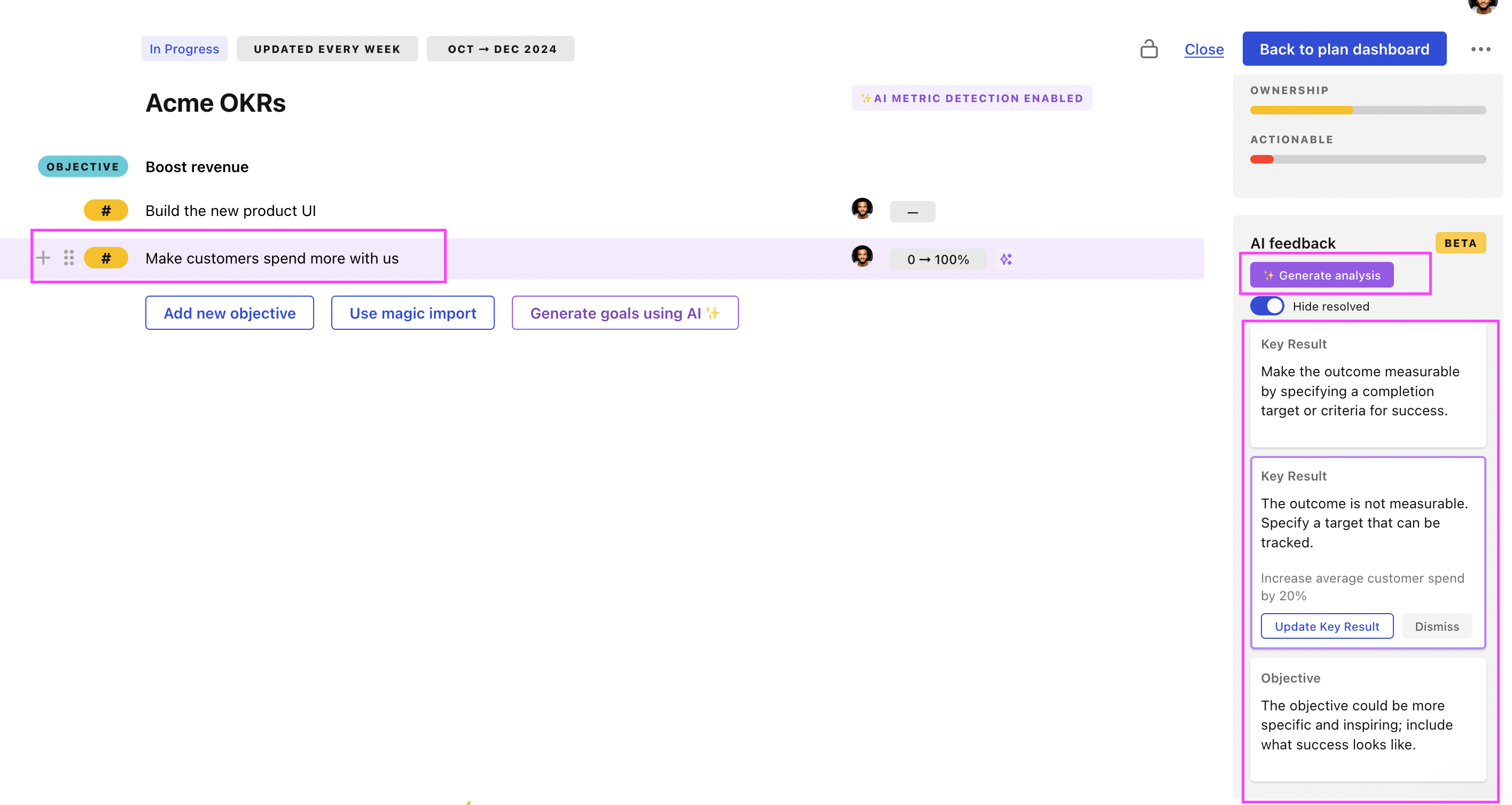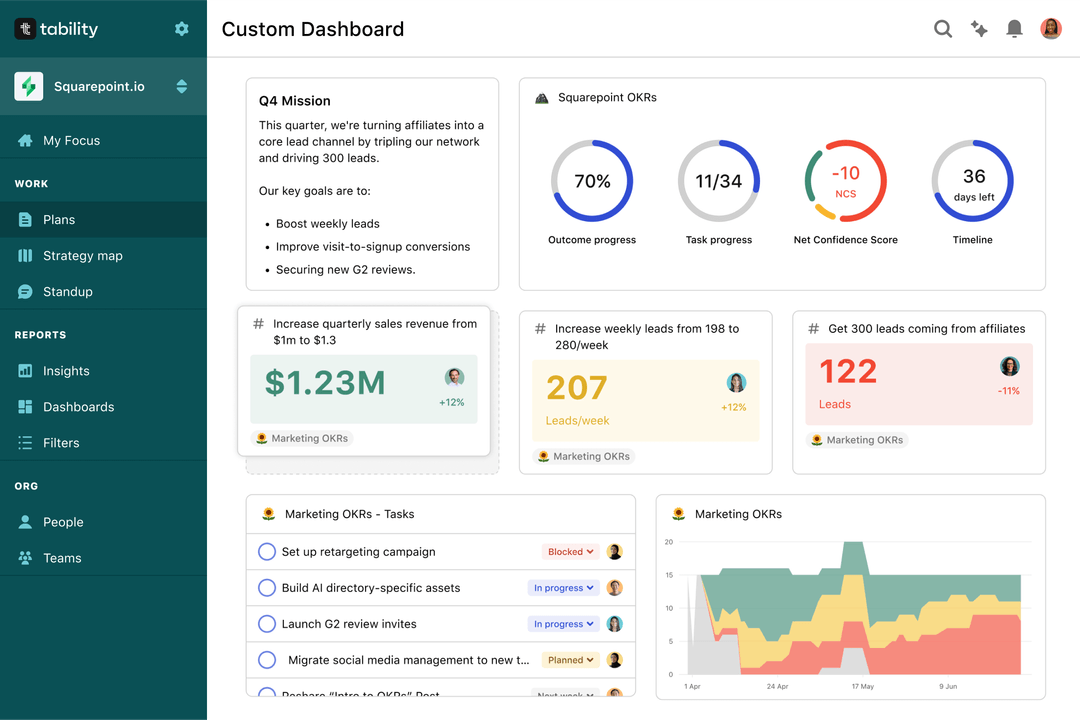Tability is a cheatcode for goal-driven teams. Set perfect OKRs with AI, stay focused on the work that matters.
What are Maintenance Worker OKRs?
The Objective and Key Results (OKR) framework is a simple goal-setting methodology that was introduced at Intel by Andy Grove in the 70s. It became popular after John Doerr introduced it to Google in the 90s, and it's now used by teams of all sizes to set and track ambitious goals at scale.
How you write your OKRs can make a huge difference on the impact that your team will have at the end of the quarter. But, it's not always easy to write a quarterly plan that focuses on outcomes instead of projects.
That's why we have created a list of OKRs examples for Maintenance Worker to help. You can use any of the templates below as a starting point to write your own goals.
If you want to learn more about the framework, you can read our OKR guide online.
The best tools for writing perfect Maintenance Worker OKRs
Here are 2 tools that can help you draft your OKRs in no time.
Tability AI: to generate OKRs based on a prompt
Tability AI allows you to describe your goals in a prompt, and generate a fully editable OKR template in seconds.
- 1. Create a Tability account
- 2. Click on the Generate goals using AI
- 3. Describe your goals in a prompt
- 4. Get your fully editable OKR template
- 5. Publish to start tracking progress and get automated OKR dashboards
Watch the video below to see it in action 👇
Tability Feedback: to improve existing OKRs
You can use Tability's AI feedback to improve your OKRs if you already have existing goals.
- 1. Create your Tability account
- 2. Add your existing OKRs (you can import them from a spreadsheet)
- 3. Click on Generate analysis
- 4. Review the suggestions and decide to accept or dismiss them
- 5. Publish to start tracking progress and get automated OKR dashboards

Tability will scan your OKRs and offer different suggestions to improve them. This can range from a small rewrite of a statement to make it clearer to a complete rewrite of the entire OKR.
Maintenance Worker OKRs examples
We've added many examples of Maintenance Worker Objectives and Key Results, but we did not stop there. Understanding the difference between OKRs and projects is important, so we also added examples of strategic initiatives that relate to the OKRs.
Hope you'll find this helpful!
OKRs to boost efficiency in maintenance jobsv
ObjectiveBoost efficiency in maintenance jobsv
KRAchieve 75% first-time-fix rate by developing staff troubleshooting skills
Foster regular role-play exercises for troubleshooting
Implement a comprehensive skill development program
Evaluate and provide feedback on each staff's performance
KRReduce repeat maintenance jobs by 15% through enhanced job protocols
Train staff in upgraded procedures
Develop comprehensive, enhanced job protocols
Monitor and measure maintenance effectiveness regularly
KRImplement and optimize job tracking to improve accountability and efficiency
Develop a comprehensive and efficient job tracking system
Train employees on tracking tool usage
Regularly assess and tweak for optimal results
OKRs to replace toilet flush valves in Building 1 before the construction project
ObjectiveReplace toilet flush valves in Building 1 before the construction project
KRAchieve 100% replacement and functional testing of all flush valves by week 6
Inventory all flush valves by end of Week 1
Complete replacement and testing by Week 6
Order replacement parts by Week 3
KRIdentify and purchase necessary valve replacement materials by week 2
Research suppliers with best prices for materials
Complete purchase of valve replacement materials
Determine necessary valve replacement materials
KRComplete replacement of 50% toilet flush valves by week 4
Select supplier and purchase 50% of needed replacement toilet flush valves
Inspect and verify installation of new flush valves by week 4
Schedule installation time with building maintenance workers
Maintenance Worker OKR best practices
Generally speaking, your objectives should be ambitious yet achievable, and your key results should be measurable and time-bound (using the SMART framework can be helpful). It is also recommended to list strategic initiatives under your key results, as it'll help you avoid the common mistake of listing projects in your KRs.
Here are a couple of best practices extracted from our OKR implementation guide 👇
Tip #1: Limit the number of key results
The #1 role of OKRs is to help you and your team focus on what really matters. Business-as-usual activities will still be happening, but you do not need to track your entire roadmap in the OKRs.
We recommend having 3-4 objectives, and 3-4 key results per objective. A platform like Tability can run audits on your data to help you identify the plans that have too many goals.
Tip #2: Commit to weekly OKR check-ins
Don't fall into the set-and-forget trap. It is important to adopt a weekly check-in process to get the full value of your OKRs and make your strategy agile – otherwise this is nothing more than a reporting exercise.
Being able to see trends for your key results will also keep yourself honest.
Tip #3: No more than 2 yellow statuses in a row
Yes, this is another tip for goal-tracking instead of goal-setting (but you'll get plenty of OKR examples above). But, once you have your goals defined, it will be your ability to keep the right sense of urgency that will make the difference.
As a rule of thumb, it's best to avoid having more than 2 yellow/at risk statuses in a row.
Make a call on the 3rd update. You should be either back on track, or off track. This sounds harsh but it's the best way to signal risks early enough to fix things.
Save hours with automated Maintenance Worker OKR dashboards

OKRs without regular progress updates are just KPIs. You'll need to update progress on your OKRs every week to get the full benefits from the framework. Reviewing progress periodically has several advantages:
- It brings the goals back to the top of the mind
- It will highlight poorly set OKRs
- It will surface execution risks
- It improves transparency and accountability
Spreadsheets are enough to get started. Then, once you need to scale you can use Tability to save time with automated OKR dashboards, data connectors, and actionable insights.
How to get Tability dashboards:
- 1. Create a Tability account
- 2. Use the importers to add your OKRs (works with any spreadsheet or doc)
- 3. Publish your OKR plan
That's it! Tability will instantly get access to 10+ dashboards to monitor progress, visualise trends, and identify risks early.
More Maintenance Worker OKR templates
We have more templates to help you draft your team goals and OKRs.
OKRs to enhance QAQC protocols in construction operations
OKRs to increase savings towards the 10k annual goal
OKRs to enhance SaaS product development in our Tribe team
OKRs to author comprehensive ADRs for Google Cloud Platform at FinTech company
OKRs to boost my score to 11000
OKRs to create globally acclaimed cinematic masterpiece